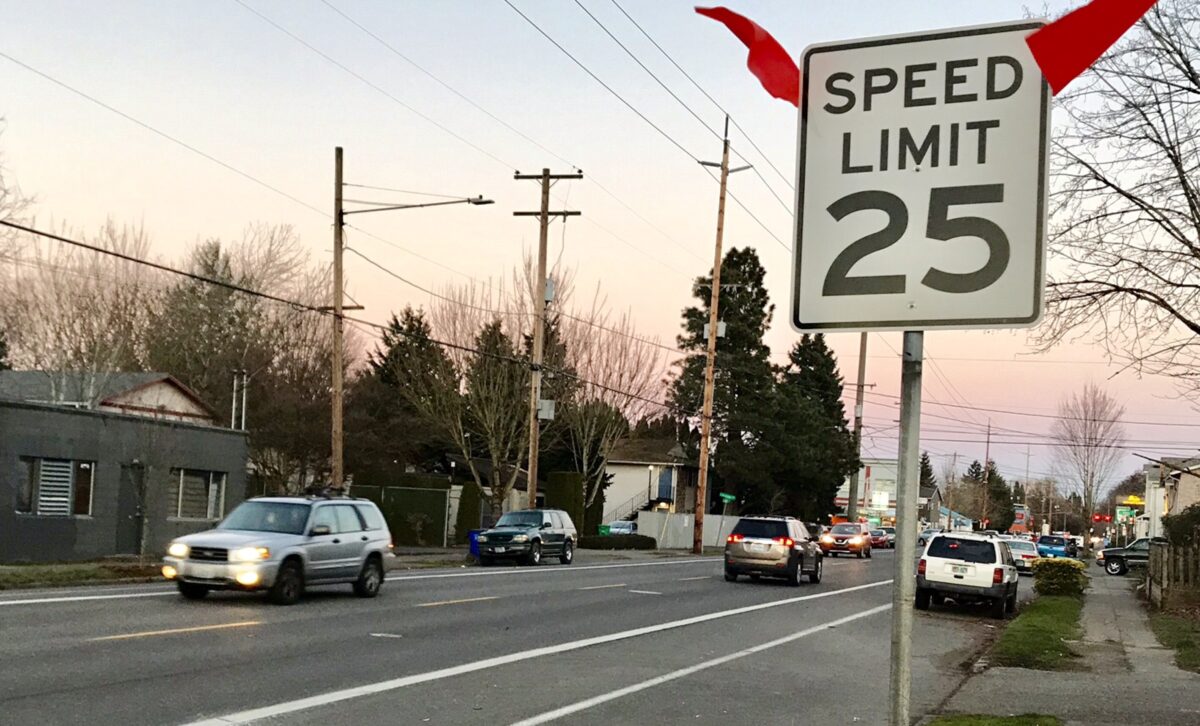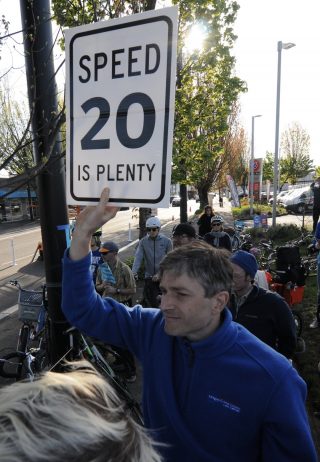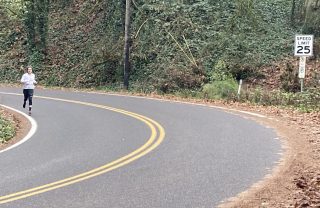
(Photo: Jonathan Maus/BikePortland)
In January 2018, armed with the fact that about half of all fatal collisions in Portland involve speeding drivers, Portland City Council passed an ordinance to, “Reduce speed limit to 20 miles per hour on residential streets to support safe travel”. It established that a designated speed (set by a local road road authority) could be set five miles per hour lower than the statutory speed (set by state law) on non-arterial streets. This led to the City of Portland’s “20 is Plenty” campaign and thousands of 20 mph signs popping up on streets citywide.
“I believe PBOT’s reluctance to comply with the ordinance on many collectors is based on fear of pushback.”

(Photo: Jonathan Maus/BikePortland)
Coming up on three years since that ordinance was adopted, Portland-based attorney and safety advocate Scott Kocher says the city isn’t fulfilling their mandate under the law and should be doing more to lower speed limits. If you’re not familiar with Kocher’s work, his firm won a settlement against the Portland Bureau of Transportation last year in a case about intersection design, and they sued PBOT back in February for failing to enforce “daylighting” at intersections. He has also written several articles for BikePortland, including a May 2019 piece about pothole dangers. (Disclaimer: Kocher’s firm, Forum Law Group, is also a financial supporter of BikePortland.)
I interviewed Kocher last week to learn more about his experiences with Portland’s new speed law and how its passage has impacted our streets. Our conversation (below) has been edited for clarity.
BikePortland: After reading your article back in January about the slow zone you helped implement with PBOT in northwest Portland, I requested 20 mph speeds on three collector streets (smaller than an arterial but larger than a local/residential street) in my neighborhood. The official denials always included this phrase, “PBOT’s policy is to maintain 25 mph posted speed limits on Major Emergency Response (MER) routes unless they are Neighborhood Greenways.” Where I live in southwest Portland, all of the collector streets are emergency response routes. What do you make of this? Does that response conform to the new law?
Kocher: I don’t know if PBOT is still telling people that, but they shouldn’t be. When I heard they were saying that a couple years ago, I met with the Portland Fire Bureau (PFB). Common sense tells us speed limit reductions don’t affect emergency response. And that’s correct. Emergency responders can activate sirens and lights, and the posted speed does not limit how fast they can go. In the more distant past, they were limited to 10 mph over the posted speed. That’s no longer true.
If anything, first responders can navigate streets more safely if other drivers are not going as fast. For example, the distance required for an emergency vehicle to pass is shorter, the closing speed of oncoming vehicles is less, and it takes other drivers less time to pull over. It’s possible some people are confusing speed limit reductions and physical measures to calm traffic. Those can have emergency response implications, which have been worked out between PBOT and PFB over the years.
Advertisement
BikePortland: PBOT installed it’s final 20 mph sign about a year and a half ago. What’s happening with “20 is plenty” today?
Kocher: I was dismayed when PBOT announced they put up their last 20 mph sign. I don’t think that’s actually true and this gets into the discussion about collectors, because the language of the ordinance is not limited to local service (also known incorrectly, Kocher warns below, as “residential”) streets.
Although people often refer to the ordinance as the “20 mph” ordinance, it actually is a five mile per hour reduction off of “the statutory speed on non-arterial streets in residence districts”. And so it obviously applies to local streets and collectors.
“The City is still making some progress with speed limit reductions… In terms of broader change, it seems we’ve mostly stalled out.”
BikePortland: And yet I keep running into the belief that the five mile per hour speed reduction applies only to local streets, that it excludes all the collector streets in residence districts. Even the recent Portland State University speed study solicited by PBOT incorrectly stated: “The Portland City Council approved an ordinance reducing the speed limit on all residential streets to 20 mi/hr in January 2018. A residential street is a street that is in a residence district according to ORS 801.430 and has a statutory speed limit. Federally classified collectors and arterials are excluded.”
I’m starting to feel gaslighted. Is PBOT fully complying with Portland’s speed reduction ordinance or not?
Kocher: The City is still making some progress with speed limit reductions, but it’s happening now on a painstaking street-by-street, segment-by-segment basis. In terms of broader change, it seems we’ve mostly stalled out. I’ve gone through the speed setting laws and city ordinance to show what is left to be done in terms of speed limit reductions within Portland just to effectuate the laws and the ordinance already on the books.
Here’s what I think we’re still missing in terms of implementation:

(Photo: Lisa Caballero)
Collectors in residence districts. All collectors in northwest are now posted 20 mph. In other parts of the city they’re not; but there’s nothing in the ordinance that allows PBOT to limit its implementation of 20 mph on collectors to northwest. PBOT messaging that the ordinance applies to “residential streets” is unhelpful. “Residential streets” is not a category in the ordinance or in state law. The categories are “local”, “collector” and “arterial” for what we think of as small, medium and large streets, respectively.
I believe PBOT’s reluctance to comply with the ordinance on many collectors is based on fear of pushback. That’s not a basis for PBOT to deny people who live on those collectors the level of comfort and safety that they’re entitled to. People in east and southwest Portland in particular have expressed concerns to me that collectors are streets where people have to walk and cross, and they don’t have sidewalks or signals. A lot of them are designated City Walkways and City Bikeways in Portland’s Transportation System Plan. Yet, we have people walking, rolling and biking in the same lane with people driving cars and trucks too fast. Nine of the 48 crashes that killed pedestrians in Portland from 2017-2019 were on collectors.
The City adopted Vision Zero, not Vision Nine, or twenty, or fifty. If the City is serious about turning around our crash numbers they need to stand up for the ordinance and implement it, not hide from it.
15 mph in school zones, which is 5 mph slower than their statutory speed of 20 mph. Most school zones are also in “residence districts” (as defined in ORS 801.430).
Advertisement
20 mph for any non-arterial street that is in a residence district and is also “in a public park.” I’m unaware of any legal guidance relating to whether this applies to streets along parks, say where there is a park on one side and residences on the other. 20 mph would be 5 mph slower than these streets’ statutory speed of 25 mph. As an aside, I am aware of some streets through parks, such as NW Cornell through Forest Park, that PBOT has not tried to reduce even to 25 mph.

(Photo: Lisa Caballero)
Narrow residential roadways. I think there’s a huge opportunity here. “Narrow residential roadways” are streets in a residence district where the portion of the street “that is improved, designed or ordinarily used for vehicular travel, exclusive of the shoulder” is not more than 18 feet wide (ORS 801.368). That means all Portland streets in residence districts that are 18 feet or narrower — not including shoulders or parking — must be posted 10 mph. And it means more than that. It means that we can achieve 10 mph on many more streets at low cost.
This is a big deal! Even if the pavement on your street is wider than 18 feet, it can be striped with a fog line, or furnished with planters, benches, etc. that limit the “used for vehicular travel” portion to 18 feet. Doing so means it can be posted at 10 mph. With a design speed of 10 mph, all sorts of traffic calming becomes possible… adding basketball hoops, street tree plantings, benches and the like would be transformative on a lot of the smaller streets throughout Portland.
A few times in the past, PBOT has floated the idea of striping walking space on streets with no sidewalks. Those plans were met with a chilly reception because the designs were based on 25 mph speed limit and people imagined drivers crashing head-on, or swerving into the walking lane at high speed. At 10 mph though, designs like that become a far more interesting option.
BikePortland: Thanks for sharing this with us Scott. Keep us posted on the work you’re doing.

— Lisa Caballero, lisacaballero853@gmail.com
— Get our headlines delivered to your inbox.
— Support this independent community media outlet with a one-time contribution or monthly subscription.


